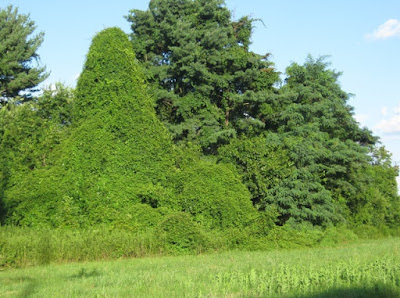 |
| Mile-a-minute choking trees © Beatriz Moisset |
Part of the reason why some introduced
organisms become invasive is that they left behind the enemies that
kept them in check in their native lands. Once free from such
restraints they can become enormously successful in their adoptive
land. When other methods of control fail conservationists have been
resorting to what I would call fighting fire with fire: bringing
another introduced species to control the one that has become a pest.
These are the so called biological controls or biocontrols. This
method is a partial admission of defeat. It allows the invasive
species to remain but minimizes its impact. The National Wildlife Federation says it best:
 |
In desperation, they imported a lady
beetle from Australia, the Vedalia beetle (Rodolia cardinalis). It
adapted well to its new environment and went right to work bringing
the pest under control and saving the citrus industry. This was the
beginning of biocontrol introductions.
However, the method may backfire with
disastrous consequences. At first, it was thought a good idea to
bring biological controls with wide tastes. It turned out that some
went after desirable bugs, not just the undesirable ones. One of the
worst examples was a parasitic tachinid fly (Compsilura concinnata)
brought in to control the gypsy moth. Unfortunately, it started
feeding on many native moths including the spectacular Cecropia moth.
Populations of some of these moths have dropped down enough to cause
serious concern.
 |
Cecropia Moth (Hyalophora cecropia)
© Marvin Smith. Wikicommons
|
Nowadays the only biocontrols allowed
are those with extremely narrow feeding habits, ideally only the
target species. The U.S. Department of Agriculture approves
biocontrols only after they have been subjected to thorough testing
under tight quarantine conditions.
I will illustrate this with two
examples that I have had the opportunity to observe: one controls an
insect pest, the other a weed.
 |
Japanese beetle
with egg of parasitic fly
© Beatriz Moisset |
 |
Mile-a-minute weevils on mile-a-minute
vine
© Beatriz Moisset
|
© 2015, Beatriz Moisset. First published in Native Plants and Wildlife Gardens 2/7/15
